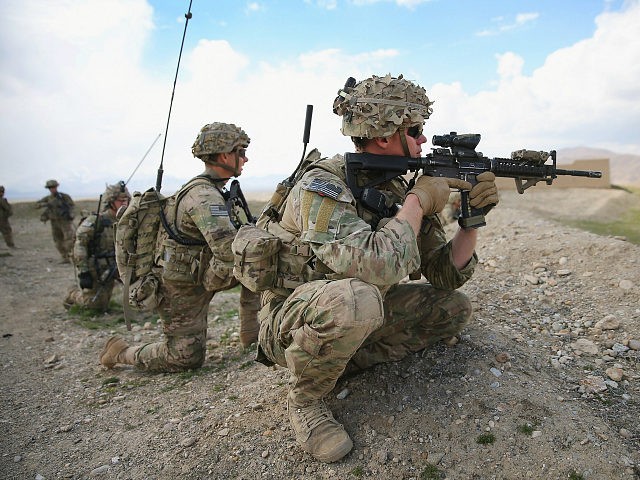Although President Trump’s speech on Monday night did not include any specific troop numbers for Afghanistan, Fox News claims an unnamed senior official told them 4,000 more troops have been approved for the mission. Other sources have said the exact number will be closer to 3,800.
This would increase U.S. forces in Afghanistan to about 12,500, far below the high-water mark of over 100,000 reached in the summer of 2010. According to the timeline of troop deployments produced by Military Times, the enhanced force approved by President Trump will be somewhat smaller than the U.S. military presence in Afghanistan as of December 2003.
The UK Guardian notes the plan for about 4,000 more troops was prepared months ago and authorized by the White House in June, but Defense Secretary James Mattis delayed implementation while the president considered alternative strategies. Taking a much tougher stance against Pakistani indulgence of the Taliban seems to be the major alteration made to the plan presented in June.
The Guardian quotes analysts who believe President Trump’s criticism of Pakistan and embrace of India might be counterproductive because it will prompt Pakistan (and possibly China) to support terrorist forces in Afghanistan even more.
The other side of that argument is that threatening Pakistan and China with more Indian involvement might persuade them to back off on aiding the Taliban. If, as these analysts told the Guardian, Pakistani intelligence supported Afghan militants because they feared a greater Indian presence, then threatening them with a guaranteed Indian presence to battle the resurgent Taliban might force the Pakistanis to adjust their nefarious calculations.
Fox News quotes U.S. Air Force estimates that airstrikes in Afghanistan have roughly tripled under President Trump, compared to the same period in President Obama’s last year. 1,984 airstrikes were conducted between January and July 2017.
According to the New York Times, President Trump was angered by Pentagon proposals for more troops during a July 19 Situation Room meeting. According to the NYT’s source, his anger was fueled in part by a lunch meeting the previous day with four soldiers who served in Afghanistan, a meeting that left him “sober about the prospects for turning around a war that has dragged on for nearly 16 years” and “determined to ask hard questions.”
Those questions included “What does success look like?” when security officials presented Trump with a plan for perpetual troop deployments and no firm victory conditions.
According to the Times’ account, several factors moved President Trump to dispatch more troops, after criticizing the status quo in Afghanistan for many years: the perilous condition of the Afghan government; fear that the Islamic State might establish a new power base in Afghanistan to replace lost ground in Syria and Iraq; support for the Pentagon’s proposals from Vice President Mike Pence and Secretary of State Rex Tillerson; the arrival of retired Marine General John F. Kelly as White House chief of staff; and reluctance by CIA Director Mike Pompeo to commit his agency to the covert counterterrorism strategy advocated by Steve Bannon.
The Washington Post mentions more factors in Trump’s decision-making process: the high value he placed on being seen as a “strong and decisive leader”; Secretary of Defense James Mattis bringing the president up to speed on the role Pakistan has played in the Taliban’s resurgence; Mattis and McMaster convincing Trump that Taliban or ISIS victory in Afghanistan would have devastating “ripple effects” across the region; and most intriguingly, McMaster showing Trump a 1972 photo of “Afghan women in miniskirts walking through Kabul,” to convince the president that Afghanistan was once a modern Western-leaning country and could become one again.
The Post quotes former Speaker of the House Newt Gingrich saying that Trump was, in essence, persuaded that Afghanistan could be renovated along the lines of postwar Korea, Germany, and Japan with a light but long-term American military presence, provided casualties are kept to a minimum. The latter provision is evidently why the troop deployment approved by President Trump is much smaller than what the Pentagon and National Security Adviser McMaster originally envisioned.
Sources for both the New York Times and Washington Post agreed that McMaster was deeply annoyed with the proposal from former Blackwater CEO Erik Prince to draw down U.S. troops and replace them with private security contractors.
Public opinion on Afghanistan is a complicated subject, as the Washington Post discovered while trying to pick through various opinion polls to get a sense of where various portions of the electorate stand. Broadly speaking, the public is closer to Candidate Trump’s aversion to committing more troops to a seemingly endless and pointless mission in the bleak Graveyard of Empires, but Trump’s base voters actually seem to favor sending more troops and getting the job done more than any other segment of the electorate.

COMMENTS
Please let us know if you're having issues with commenting.